
There were already quite a few other ships at anchor and several more were maneuvering to anchor. Suddenly we heard an enormous bang causing everybody including the crews on the other ships to rush to the railings just in time to see an enormous pillar of water crashing down on the foreship of a freighter some 80 meters away.
When the ship began to sink towards the bow our captain gave the order to lower the motor launches and ordered the crew to give assistance where needed. The nice thing was that all ships at anchor lowered their boats without any prior agreement. And so a small fleet of rescue boats sailed to the disaster area. From the shore came a couple of tugboats, there was plenty of help. We were now hoping that nobody was killed or injured. It was not long before all the rescue boats returned to their ships but as yet nobody knew what had happened.
After the long journey from Colombo we had little to talk about so this was a great occasion for a new subject to air your opinion on. It was eventually agreed that it had been an explosion in hold no1. The following morning we came to know that a German Aircraft had dropped a number of mines in the bay and this ship had sailed onto one of these mines. We had a lot to learn yet! The result was that no ship could either come in or go out of the bay and all had to remain at anchor until a few mine sweepers had cleared the bay.
A few days later we received orders to weigh anchor and sail to London. It was considered safer to sail north of Scotland in a small convoy and after that along the entire East Coast of England to the Thames. Accordingly we sailed North, passed the strait between North-Scotland and the Orkney islands and came down the East Coast. Every thing was quiet , and for us too quiet. We were going a little over half speed as the rest could not go faster.
During the night we came level with the town of Hull were we saw a large glow of huge fires ashore and saw the flashes from anti aircraft guns. This again was something new for us: witnessing an air attack on a town. We heard nothing, even on deck there was always noise from the exhausts of main and auxiliary motors. Too late we heard the noise of an aircraft swooping low over the ship emptying its machine guns on it and we did not see that it dropped a bomb aimed at the ship! Luckily it missed and detonated with an enormous bang some thirty meters behind us in our wake. Great panic and alarm bells!. Everybody wide awake, those who were in their bunks got dressed and everybody put on their life jackets. We could do absolutely nothing to defend ourselves because we did not have a single weapon. The only bullets we had on board were the ones that German Aircraft fired at us. There were two which had come in through the ventilator onto the floor of the engine room and a couple in the wardrobe of the Chief Engineer who at the time was not in his cabin. He only realized this in the morning when he saw the bullet holes in his wardrobe. Because nothing else had happened for an hour after the attack everybody could carry on with what he had been doing. If one still had a mind to do so.
Without further interruptions we finally reached London where we tied the ship up at the wharf of The Royal Albert Dock next to an immense silo, a concrete colossus, which was still being finished. On the eight of August 1940 we started to unload our valuable cargo.
<< previous chapter ———————————–next chapter >>

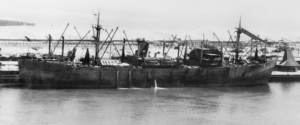
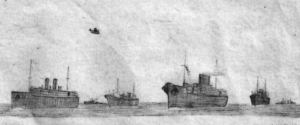
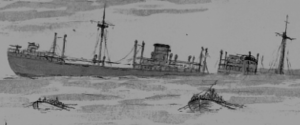
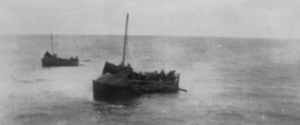
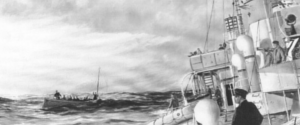
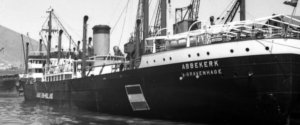






On 21 july 1940 the SS Troutpool was sunk when she hit a mine leaving Belfast Lough. 11 crewmembers were killed.
Abbekerk was lucky here: she didn’t have maps of the harbour and therefore her master anchored at the entrance on the 21st and refused to move on before she had maps and a pilot. Troutpool sank between Abbekerk and the spot the port authorities had wanted Abbekerk to anchor.
More on this event: http://ww2talk.com/index.php?threads/belfast-lough-condor.20367/